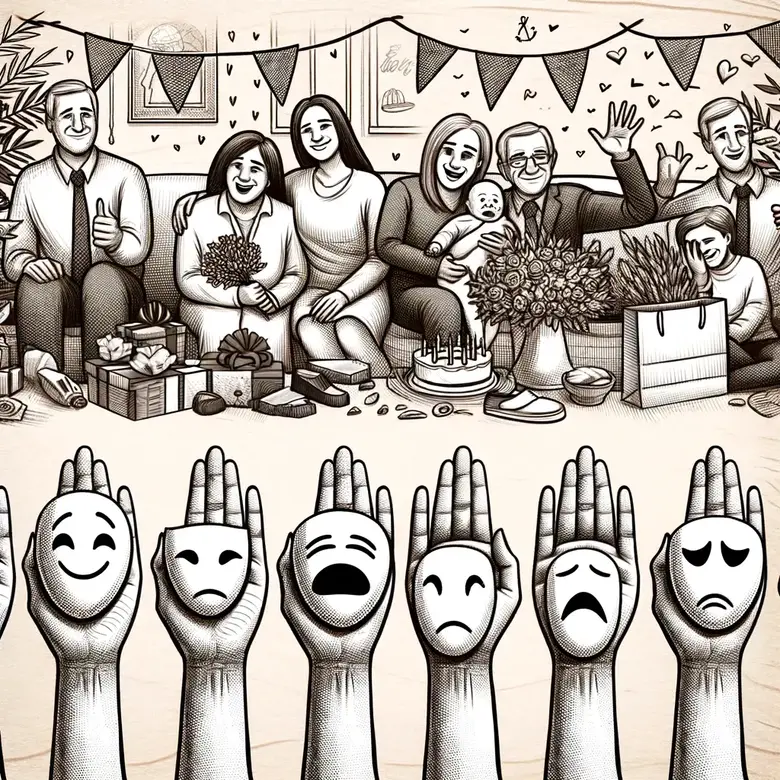The Hidden Burden of Emotional Labor in Work and Home

Imagine attending a dinner party where the host, Sarah, gracefully ensures every guest feels welcomed and comfortable. Her warm smile never fades, yet beneath the surface, she bears the weight of unspoken responsibilities and emotional management.
This scenario exemplifies emotional labor, the often invisible effort involved in managing one’s own emotions and the emotions of others to meet societal expectations.
Coined by sociologist Arlie Hochschild in her 1983 book The Managed Heart, emotional labor originally described the process by which workers manage their emotions to fulfill the emotional requirements of their jobs.
Over time, this concept has expanded beyond the workplace, encompassing the myriad ways individuals navigate emotional expectations in daily life.
What is emotional labor?
“Emotional labor” refers to the exertion involved in managing and tempering our emotions. We do this to adhere to social norms or job expectations. It’s a form of labor that often doesn’t get acknowledged.
It plays a critical role in our emotional state and overall well-being. And let me be clear. The mental load of this kind of labor can be just as exhausting as any physical task. It can be even more exhausting.
As we venture further into this topic, we’ll dissect the different dimensions of emotional labor. This includes the workplace and intimate relationships.
We’ll also explore ways to manage this invisible burden to improve your emotional well-being and your interactions with others. After all, awareness is the first step toward transformation.
So, are you ready to shed light on this often-overlooked aspect of your life?

Who First Defined Emotional Labor, and How Has It Changed?
Arlie Hochschild’s The Managed Heart: Commercialization of Human Feeling, published in 1983. It introduced the world to the concept of emotional labor.
Hochschild’s research highlighted how workers, especially in service industries, manage and manipulate their emotions to meet job expectations.
Since then, this idea has expanded beyond the service industry, becoming relevant in everyday social and professional settings. Her groundbreaking work was once thought to apply primarily to specific roles like flight attendants.
We now see it impacting everyone. This ranges from a CEO in a boardroom to a mother managing household dynamics.
Hochschild’s original focus was narrow, but emotional labor has evolved into a concept that pervades many aspects of our lives. Emotional labor occurs whether it’s managing your emotions at a family gathering.
It also happens when presenting a calm facade at work. It is always there, shaping our daily experiences.
How Emotional Labor Affects Your Job and Mental Health
Have you ever forced a smile at work, even when stressed or frustrated? That’s emotional labor in action. It’s not just about pretending to be happy—it’s the ongoing effort to regulate emotions to meet workplace expectations.
A 2021 study by the American Psychological Association (APA) found that 60% of customer service employees experience emotional exhaustion, often leading to burnout.
Healthcare workers face a similar struggle. According to the American Medical Association (AMA), over 50% of doctors and nurses report burnout, with emotional labor as a major contributing factor.
But emotional labor isn’t just an issue in frontline jobs—it’s also prevalent in leadership roles. A Harvard Business Review survey found that over 70% of executives admit they suppress emotions to maintain authority, making leadership positions mentally exhausting.
Why Does Emotional Labor Lead to Burnout?
When your job requires constant emotional regulation, staying upbeat with customers, or appearing confident in a high-stakes meeting—it drains your psychological resources.
Over time, this emotional dissonance (the gap between what you feel and what you express) leads to:
🔹 Fatigue and burnout – Chronic emotional suppression wears down mental resilience.
🔹 Increased stress and anxiety – Holding in frustration or sadness raises cortisol levels.
🔹 Job dissatisfaction – Feeling forced to display emotions that aren’t genuine can make work feel inauthentic
How to Reduce Emotional Labor at Work
Instead of masking emotions 24/7, consider setting emotional boundaries and advocating for healthier workplace dynamics:
✅ Recognize the signs – If you leave work feeling emotionally drained, it’s a signal that your emotional labor is unsustainable.
✅ Communicate openly – Talk with your manager about the emotional toll certain job expectations take on your well-being.
✅ Use emotional authenticity – Instead of forced positivity, practice genuine emotional expression where appropriate.
✅ Take micro-breaks – Stepping away, even for a few minutes, can help reset your emotional energy.
By addressing emotional labor instead of just tolerating it, both employees and leaders can create a workplace that values mental well-being as much as productivity.
How Emotional Labor Impacts Relationships (and How to Balance It)
Have you ever felt like the emotional caretaker in your relationship? Maybe you’re the one who always smooths over conflicts, checks in on your partner’s mood, or keeps conversations flowing at family gatherings.
If so, you’re carrying emotional labor, the unseen work of managing emotions to keep stability in relationships.
This invisible burden is often unevenly distributed. Studies show that women are more likely to take on emotional labor in both personal and professional settings, sometimes at the of their mental health.
However, men and non-binary individuals also experience emotional labor, though they may feel pressure to suppress it due to societal expectations.
Signs You’re Carrying Too Much Emotional Labor in a Relationship
Emotional labor isn’t just about supporting a partner—it becomes unhealthy when one-sided. Here are common signs that you may be shouldering more than your fair share:
🔹 You always mediate conflicts – If you’re constantly diffusing arguments or acting as the “peacemaker,” you’re likely doing extra emotional work.
🔹 Your emotional needs take a backseat – You support your partner, but when you’re struggling, you don’t get the same level of care.
🔹 You feel emotionally exhausted – If being around your partner feels draining rather than fulfilling, it’s a sign of imbalance.
🔹 You manage their social and family dynamics – Remembering birthdays, keeping peace at family events, or ensuring they maintain friendships—all of that is emotional labor.
How to Balance Emotional Labor in Your Relationship
If emotional labor is weighing you down, here’s how to create a healthier dynamic:
✅ Talk about it openly – Many partners don’t realize how much emotional labor they’re offloading. Have an honest conversation about how you feel.
✅ Set boundaries – You don’t have to be the constant fixer. It’s okay to step back and let others handle their own emotions.
✅ Share responsibilities – If you’re always the only one checking in on emotional well-being, suggest taking turns.
✅ Prioritize your needs – Emotional labor shouldn’t come at the cost of your mental health. Make space for self-care.
A balanced relationship means both partners contribute to emotional well-being, not just one. Recognizing emotional labor is the first step toward redistributing the load so neither person feels overwhelmed.

Emotional Labor in Social Interactions
Have you ever felt utterly exhausted after attending a social event, even though you didn’t exert yourself physically? That’s emotional labor at work. In social interactions, we often adjust our emotions to fit the expectations of the situation.
You might laugh at jokes you don’t find funny. You might also show interest in conversations that bore you. All this is done to maintain social harmony.
Social media adds another layer to this dynamic. Research from the Pew Research Center shows that 70% of adults in the U.S. use social media, where they curate their online personas to meet social expectations.
This curation is a form of emotional labor that can be just as taxing as in-person interactions.
So, what are these norms costing you? Are you aware of how your emotional state fluctuates as you navigate these social norms?
In unfolding this subject, we’re not just identifying patterns; we are also permitting ourselves to question them. By becoming aware of the invisible work, you can choose how to engage in this complex emotional ecosystem.
Subscribe to Create Higher Vibrations!
Get Inspiration and Practical advice straight to your inbox.
Who Carries the Heaviest Emotional Labor? (And Why It’s Often Overlooked)
Not all emotional labor is distributed equally. Some people carry a heavier load simply because of their gender, race, or social role, often without recognition.
Studies show that women, BIPOC (Black, Indigenous, and People of Color), and non-binary individuals are disproportionately expected to manage emotions in both personal and professional spaces.
Why Women Carry More Emotional Labor
Historically, women have been expected to be emotional caretakers, both in families and workplaces. This is backed by research showing that women:
🔹 Take on more household emotional work – They are more likely to remember birthdays, plan family events, and mediate conflicts.
🔹 Are expected to be emotionally available – Whether supporting a partner’s stress or managing kids’ emotions, women often shoulder unpaid emotional labor.
🔹 Face emotional labor at work – Studies from the Harvard Business Review show that women are more likely to take on tasks like mentoring colleagues, handling office disputes, and supporting coworkers emotionally, without extra pay.
BIPOC Communities and the Extra Layer of Emotional Labor
For many Black, Indigenous, and People of Color (BIPOC) individuals, emotional labor isn’t just personal—it’s deeply tied to societal expectations.
🔹 Managing bias and microaggressions – Many BIPOC individuals are expected to “stay calm” in the face of discrimination, which adds to their emotional burden.
🔹 Educating others on racial issues – A 2021 study by the American Psychological Association found that many people of color feel pressured to explain racial issues to others—an unpaid form of emotional labor.
Non-Binary and LGBTQ+ Individuals: Emotional Labor in Identity Advocacy
Non-binary and LGBTQ+ individuals often carry a unique type of emotional labor—the constant need to explain their identity, navigate social bias, and manage societal expectations.
🔹 Explaining pronouns and identity – Many non-binary individuals report feeling exhausted from repeatedly educating others.
🔹 Suppressing emotions for safety – Research shows that LGBTQ+ individuals often hide parts of their identity in certain spaces, which takes an emotional toll.
How to Lighten the Emotional Load
If you or someone you know is carrying too much emotional labor, here’s how to create a more balanced system:
✅ Acknowledge the invisible work – Simply recognizing emotional labor makes a difference. Talk about it openly.
✅ Share responsibility – If one person is always the emotional caretaker, redistribute tasks in relationships and workplaces.
✅ Offer support, not just expectations – Instead of assuming someone will provide emotional labor, ask how you can contribute.
By recognizing who carries the heaviest emotional labor, we can start sharing the load more fairly, leading to healthier relationships, workplaces, and communities.

Consequences of Emotional Labor
The hidden costs of emotional labor are staggering. A customer service representative like Sarah might end her day feeling emotionally drained after handling countless calls from frustrated customers.
Studies show that 60% of service workers report emotional exhaustion, often without recognition of the toll it takes.
Healthcare professionals are similarly affected. According to the AMA, half of healthcare workers report burnout, largely due to the emotional demands of their jobs.
Even in corporate settings, executives experience emotional fatigue from constantly managing their public personas.
What Happens If You Ignore Emotional Labor
When emotional labor goes unrecognized, the consequences ripple through every aspect of life. From burnout to strained relationships, the effects are profound.
In workplaces, emotional labor imbalances can foster toxic environments, affecting morale and productivity. In personal relationships, the unequal distribution of emotional labor can lead to tension and resentment.
Sharing the Emotional Load
The first step in addressing emotional labor is acknowledging its existence. Whether it’s at work or in personal relationships, emotional labor should be recognized and shared more equitably.
Educating yourself and having open conversations can lead to a more balanced emotional workload.
Final Takeaway
Emotional labor isn’t just a burden; it’s a shared responsibility that affects every aspect of our lives. Recognizing the invisible work you and others do daily is the first step toward redistributing the load.
In workplaces and relationships, open dialogue and acknowledgment of emotional labor can lead to a healthier life. It can also create a more balanced life for everyone involved.
Are you ready to take the next step in understanding and sharing the weight of emotional labor? The path ahead begins with awareness and leads to action.


